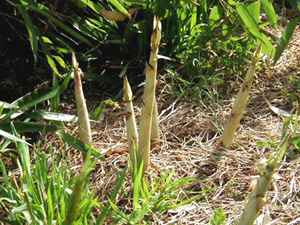|
 Bamboo,
which is in the
grass family, grows to heights that vary from a few inches to more than 100 feet.
Bamboo is differentiated from other grasses by its woody "culms,"
or stalks. Although it usually grows in tropical or subtropical climates, some
species have adapted to cooler areas with higher rainfall. Generally, bamboo
is about half water, and new shoots have an even higher water content, making
bamboo an excellent water source for pandas. More than 2,000 different species have been identified,
according to the American Bamboo Society, and more than 200 of these species
are under cultivation throughout the United States. Bamboo,
which is in the
grass family, grows to heights that vary from a few inches to more than 100 feet.
Bamboo is differentiated from other grasses by its woody "culms,"
or stalks. Although it usually grows in tropical or subtropical climates, some
species have adapted to cooler areas with higher rainfall. Generally, bamboo
is about half water, and new shoots have an even higher water content, making
bamboo an excellent water source for pandas. More than 2,000 different species have been identified,
according to the American Bamboo Society, and more than 200 of these species
are under cultivation throughout the United States.
Fortunately
for the pandas at the National Zoo, one of the species of bamboo
that they eat, Phyllostachys aureosulcata, is the species growing on Tufts' property. Sometimes called Yellow Groove or
Golden Groove bamboo for
the yellow grooves that alternate on its stalks, this species
grows to heights of 10 feet to 25 feet. Originally from China, it
can withstand temperatures as cold as 10 degrees below zero Fahrenheit.


Giant
pandas are in danger of extinction, in large part because human activity threatens
their habitat and food supply. They depend on bamboo for food and are at
risk when habitats suitable for bamboo are destroyed. What some don't realize is
that millions of people in Asia also depend on bamboo; they eat its shoots and
seeds and feed stems and leaves to their livestock. They also craft all
sorts of instruments out of bamboo, including furniture, musical instruments
and toys. Fortunately, the bamboo that grows on Tufts' farm grows
extraordinarily quickly. The shoots pictured here are already about 6 or 7 inches tall, and they are only a few days old.


Tufts
hopes that her
property will remain undeveloped, but isn't sure what will happen after she
passes away and the farm is transferred to another member of her
family. She is working with the National Wildlife Federation to
preserve the land.

Back
1 -
2 -
3 -
4
-
5 -
6 -
7 -
8 -
9 -
10
Next
|
